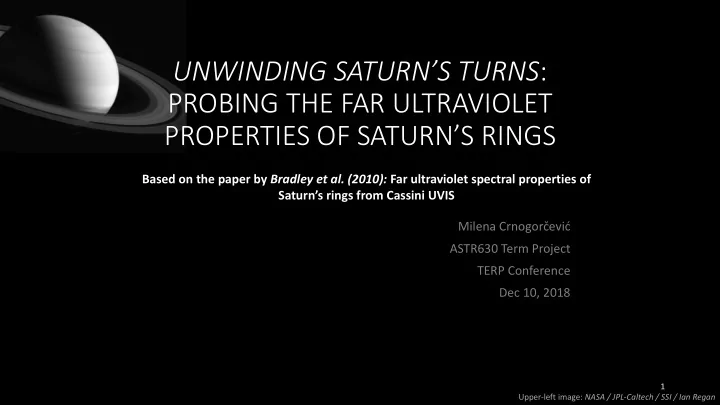

UNWINDING SATURN’S TURNS : PROBING THE FAR ULTRAVIOLET PROPERTIES OF SATURN’S RINGS Based on the paper by Bradley et al. (2010): Far ultraviolet spectral properties of Saturn’s rings from Cassini UVIS Milena Crnogorčević ASTR630 Term Project TERP Conference Dec 10, 2018 1 Upper-left image: NASA / JPL-Caltech / SSI / Ian Regan
Motivation • Saturn’s rings composed mostly of water ice ( Cuzzi et al. 1984 ) • Decrease in reflectivity shortward of 600 nm à non-icy constituents affecting the scattering properties of the ring particles • Water-ice absorption feature at around 160 nm • its properties depend on the scattering distance photons travel through water-ice, as well as the absorption properties of the regolith water-ice • can use spectral information to characterize mean free path and the symmetry parameters of the rings Fig 1. (corresponds to Fig. 2 in the paper) Normalized radiance from four different regions summed over four years of observations. Obvious absorption 2 feature present at ~ 160 nm. Upper-right image: NASA / JPL-Caltech / SSI
Authors: Cassini division A Ring B Ring C Ring • Considered four years of Cassini data applying certain selection criteria • Data reduction steps accounted for skewed field of view and other geometry effects • Produced I/F spectral plots • Fit Hapke and Shkuratov model (water-ice albedo) to the data • Found limits on L (mean free path length), g (symmetry parameter across the rings), UV slope, and I/F 3
What did I do? Cassini division A Ring B Ring C Ring • Considered four years of Cassini data • Using the selection criteria from the applying certain selection criteria paper, came up with a list of 760 observations • Data reduction steps accounted for skewed field of view and other geometry effects • Considered Ring B only (32 observations) • Produced I/F spectral plots • Fit Hapke and Shkuratov model (water-ice • Data reduction steps partially albedo) to the data reproduced • Found limits on L (mean free path length), g • I/F spectral plot for Ring B partially (symmetry parameter across the rings), UV reproduced using the limited amount of slope, and I/F data 4
• Selection criteria: • Wavelength and flux calibration • Considering the lit side of Saturn’s • GEOM routines to account for the rings, phase angles 5 to 30 deg skewed field of view and • Slit width: high and low resolution, appropriately binning the data no occulation data • Lyman-alpha forest accounting • Considering only the far-UV • Calibrating it to the Sun’s flux at observations (111.5 – 191.2 nm) the given time • 760 observations (Ring A (3), Ring B (32), Ring C (18), and the rest combination of two or more, or not mentioned in the paper) • Data reduction: • Background • Flagging the ”evil” pixels Fig 2. (analogous to Fig 1) Normalized radiance from Ring B for one of the observations (FUV2005_230_15_15). Similar absorption feature may be seen, 5 but more data is necessary to conduct any further analysis.
Paper’s conclusions and its potential extensions • Conclusions: • Potential future work: • retrieved a measure of the • More data available since 2008 amount of the water ice that UV • Consider more spatial coverage photons traverse before leaving and include more rings the ring from the location of the • Consider different radiative absorption edge in data transfer models as applied to the • Mean free path: relatively uniform rings from the mid-B ring to the outer A ring, minimum in the inner C ring • Lack of correlation between L and UV slope 6
Thanks! Questions? 7
…and today… 8
Recommend
More recommend